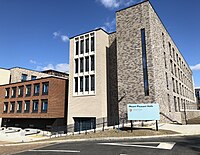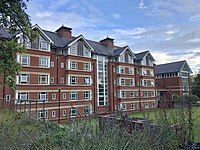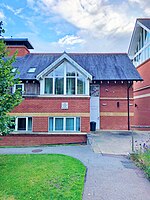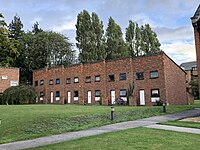St Edmund's College, Cambridge
| St Edmund's College Latin: Collegium Sancti Edmundi
| |||||||||||||||||||
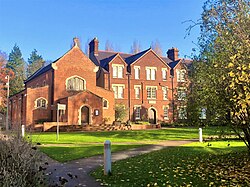 St Edmund's College Chapel | |||||||||||||||||||
|---|---|---|---|---|---|---|---|---|---|---|---|---|---|---|---|---|---|---|---|
| Master: | Catherine Arnold | ||||||||||||||||||
| Website: | st-edmunds.cam.ac.uk | ||||||||||||||||||
| |||||||||||||||||||
| Location | |||||||||||||||||||
| Grid reference: | TL44215926 | ||||||||||||||||||
| Location: | 52°12’46"N, -0°6’33"E | ||||||||||||||||||
St Edmund's College is a constituent college of the University of Cambridge, in Cambridgeshire. It is a late-Victorian foundation, founded in 1896, and is one of the four Cambridge colleges oriented to mature students, which accept only students reading for postgraduate degrees or for undergraduate degrees if aged 21 years or older.
The foundation was determinedly Roman Catholic in orientation, driven by the Duke of Norfolk and Baron Anatole von Hügel (1854–1928), the first Roman Catholic to take a Cambridge degree since the deposition of King James II in 1688.[1] The Visitor is the Roman Archbishop of Westminster.[2]
The college is named after Edmund Rich, Edmund of Abingdon (1175–1240), who was the first known Oxford Master of Arts and Archbishop of Canterbury from 1234 to 1240.
The college is found on Mount Pleasant, north-west of the centre of Cambridge, near Lucy Cavendish College, Murray Edwards College and Fitzwilliam College. Its campus consists of a garden setting which in the days of the Roman Empire was at the edge of the town, then known as Duroliponte.
History
Foundation
St Edmund's House was founded in 1896 by Henry Fitzalan-Howard, the 15th Duke of Norfolk, and Baron Anatole von Hügel as an institution providing board and lodging for Roman Catholic students at the University of Cambridge. After the Roman Catholic Relief Act, in particular after the Universities Tests Act 1871, students who were Roman Catholics were finally admitted as members of the University. In its early days the college functioned predominantly as a lodging house, or hall of residence, for students who were matriculated at other colleges. Most of the students, at that time, were ordained Roman priests who were reading various subjects offered by the University. The college was established in the buildings of Ayerst Hostel, which had been set up for non-collegiate students by the Reverend William Ayerst in 1884, and its founding master was Edmund Nolan, then vice-rector of St Edmund's College, Ware. In 1896 Ayerst Hostel had to close due to lack of funds, and the property was transferred to the Catholic Church.[3]
Collegiate Status
Attempts to have St Edmund's House become a constituent college of the University of Cambridge were undertaken at various junctures, but were met in pre-ecumenical days by continuing opposition from the predominantly Protestant membership of the University’s governing Regent House. Among motives cited were that the college was not self-governing and its assets were held in trust by an external body, namely, the Roman Catholic Church.[4]
The chapel was officially consecrated in 1916 by Cardinal Francis Bourne, Archbishop of Westminster.[5] A new dining hall was constructed in 1939 and the membership of the college increased steadily as it became a recognised House of Residence of the university, without college status.
In response to growing postgraduate student numbers in the early 1960s, the Regent House of the University established several Colleges primarily for postgraduate students, and St Edmund's House became one of the graduate Colleges in the University (the others being Wolfson College, Hughes Hall, Clare Hall and Darwin College). This spurred further progress regarding St Edmund's status within the University, and in 1965, the College was permitted to matriculate its own students and new fellows were elected. In 1975 St Edmund's acquired the status of an "Approved Foundation", and after the transfer of the College assets from the Roman Catholic Church to the autonomous governing body comprising the Masters and Fellows of the College in 1986, the College changed its name from "St Edmund's House" to "St Edmund's College". It received university approval for full collegiate status in 1996, and this was confirmed by the grant of its royal charter in 1998.[6][7] The college now accepts students of all faiths and none.
Buildings and grounds
Norfolk Building
The Norfolk Building is the oldest building on site, dating back to 1896 as the former Ayerst Hostel; it provided accommodation for Fr Edmond Nolan, the first Master of St Edmund's, along with the first four students of the college. Known for its clean Gothic revival style, the building underwent a three-phased extension scheme designed by Roderick Gradidge in 1989, and now houses 21st-century amenities including the Combination Room, Dining Hall, Kitchens and a Porter's office.[8]

Chapel
St Edmund's College Chapel is a fitting monument to the Roman Catholic character of the origins of the College and is unique among Colleges of the Universities of Cambridge and Oxford in following the Roman Catholic tradition.
The edifice itself is a Grade II listed building designed by the architect Benedict Williamson and was consecrated by Cardinal Francis Bourne, Archbishop of Westminster in 1916.[5] Notable for its prayerful simplicity and Gothic Revival architecture, the chapel is a Roman Catholic foundation, although it is open to members of other Christian denominations.[9] In 2003, a stained glass window depicting the ministry of St Boniface of Crediton (c. 675 - 754 AD), the apostle to Germany, was donated by Stephen Frowen and blessed by Cardinal Cormac Murphy-O'Connor, Archbishop of Westminster.
A bronze sculpture of the college patron, St Edmund of Abingdon, is located at the front of the chapel, his left hand holding a Bible. The statue is the work of Rodney Munday, an alumnus of St Edmund Hall, Oxford, and was commissioned by the College in 2007. The Chapel Schola and Choir frequently perform in concerts in collaboration with St Edmund Hall and St Edmund's College, Ware in commemoration of their Patron Saint.
Expansion
St Edmund's continues to expand and develop ints buildings. In 2000, a new residential building housing 50 students was opened, named after Richard Laws, one of the former Masters. In 2006, two new residential buildings, including rooms for 70 students as well as apartments for couples, were opened; these were named after the former Master of the College, Sir Brian Heap, and the former Vice-Master, Geoffrey Cook.
In 2016, major plans were announced for the development of two new courts and several buildings which will expand the College and provide modern, world-class facilities for the scholars and students of St Edmunds College. While contemporary, the buildings' external features and material will be in the traditional architectural vernacular that is found elsewhere in the College. Brick buildings will form the perimeter of the two new courts and a new multi-million pound student centre will frame the west side of the College. The expansion plans received planning consent from Cambridge City Council in June 2017.
Okinaga Tower
Created in 1993 by the bequest of the Teikyo Foundation, the Okinaga Tower is the college's tallest structure. Designed by architect Roderick Gradidge in 1989 it houses the Master's Lodge, as well as a suite with views of the city and was opened by the Right Honourable Betty Boothroyd, Speaker of the House of Commons.
Pictures
-
Mount Pleasant Halls front facade
-
New Court
-
Main gate
-
Sporting grounds and Brian Heap Building
-
Richard Laws Building
-
Geoffrey Cook Building
-
College orchards
-
Maisonettes for families
-
Norfolk Extension
-
Bene't House
-
College Chapel
Outside links
| ("Wikimedia Commons" has material about St Edmund's College, Cambridge) |
References
- ↑ lr387@cam.ac.uk (15 January 2014). "Baron Anatole von Hügel – Von Hügel Institute". https://www.vhi.st-edmunds.cam.ac.uk/about-us/baron.
- ↑ "St Edmund's College - University of Cambridge". https://www.st-edmunds.cam.ac.uk/news/message-visitor-college-cardinal-archbishop-westminster.
- ↑ E Leedham-Green 1996 A concise history of the University of Cambridge. Cambridge University Press: 171-2.
- ↑ Leader, Damian R. (April 1998). "A concise history of the University of Cambridge. By Elisabeth Leedham-Green. Pp. xiv+274 incl. endpapers, 45 plates and 5 figs. Cambridge: Cambridge University Press, 1996. £27.95 (cloth), £9.95 (paper). 0 521 43370 3; 0 521 43978 7". The Journal of Ecclesiastical History 49 (2): 329–380. doi:10.1017/s0022046997435832. SSN 0022-0469.
- ↑ 5.0 5.1 "St Edmund's College - University of Cambridge". https://www.st-edmunds.cam.ac.uk/chapel.
- ↑ "Development". https://www.st-edmunds.cam.ac.uk/development.
- ↑ "St Edmund's College Cambridge - Royal Charter - 1998". http://www.st-edmunds.cam.ac.uk/sites/www.st-edmunds.cam.ac.uk/files/St%20Edmund%27s%20College%20Cambridge%20-%20Royal%20Charter%20-%201998.pdf.
- ↑ "St Edmund's College - Modern Day". https://www.st-edmunds.cam.ac.uk/modern-day.
- ↑ "St Edmund's College - Chapel". https://www.st-edmunds.cam.ac.uk/chapel.
- Bill Lubenow (2008). "Roman Catholicism in the University of Cambridge: St Edmund's House in 1898". Journal of Ecclesiastical History 59 (4): 697–713. doi:10.1017/S0022046907002254.
- McClelland, V. Alan (1997). "St. Edmund's College, Ware and St. Edmund's College, Cambridge; Historical Connections and Early Tribulations". British Catholic History 23 (3): 470–83. doi:10.1017/S0034193200005811.
- Sweeney, Garret (1980). St Edmund's House, Cambridge: The First Eighty Years: A History. Cambridge: St Edmund's House. ISBN 978-0-95-071770-8.
- Walsh, Michael (1996). St Edmund's College, Cambridge, 1896–1996: A Commemorative History. Cambridge: St Edmund's College. ISBN 978-0-95-071771-5.
| Colleges of the University of Cambridge | |
|---|---|
|
Christ’s • Churchill • Clare • Clare Hall • Corpus Christi • Darwin • Downing • Emmanuel • Fitzwilliam • Girton • Gonville and Caius • Homerton • Hughes Hall • Jesus • King’s • Lucy Cavendish • Magdalene • Murray Edwards • Newnham • Pembroke • Peterhouse • Queens’ • Robinson • St Catharine’s • St Edmund’s • St John’s • Selwyn • Sidney Sussex • Trinity • Trinity Hall • Wolfson |
|
